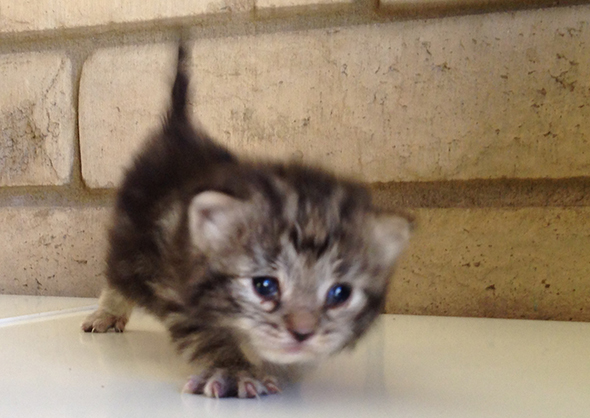
After spending nearly all of Saturday “on standby,” it had become clear by late afternoon: the mother cat, though she’d carefully relocated two siblings, wasn’t coming back for this little one. So, after a quick trip to PetSmart to stock up on supplies, I drove to the home of a former colleague who’d been keeping watch over the family for the previous few days, and, just like that: I had my first bottle baby.
Here’s this tiny kitten, three weeks old at most, in the hands of a complete novice. What could possibly go wrong? I didn’t even want to consider the possibilities.
By that point, however, I’d already tapped into a cross-country network of experts, having contacted no fewer than eight colleagues via phone, text message, and Facebook.
My crash course began by revisiting a March 25 article on Parade.com in which Best Friends colleague Janice Dankert explains what to do if you find stray kittens, which led me to the Feeding and Caring for Bottle Babies page on the Best Friends website. To estimate the kitten’s age, I turned to Alley Cat Allies’ Kitten Progression: At-a-Glance and Kitten Progression: Week-by-Week resources.
Meanwhile, advice and offers of assistance were pouring in from various colleagues at All About Animals, Alley Cat Allies, Animal Defense League of Arizona, Arizona Animal Welfare League & SPCA, Best Friends Animal Society, Fearless Kitty Rescue, and Homeless Animals Rescue Team. And yesterday, less than 48 hours after this little one (a boy, we think, who’s been given the name Squirt) came into my life, he’s in the hands of somebody far more capable than I, and headed, in due time, for adoption.
It’s an awful lot of work to save just one life, no doubt about it. And such efforts don’t always end successfully, either. (It’s easy to understand the popularity of neonatal kitten nurseries, which save thousands of lives across the country.)
I’m struck—and deeply touched—by the generosity and kindness I witnessed over the past couple of days. And I hope I don’t diminish in any way the contributions of those involved by pointing out that this kind of thing actually happens all the time. At least that’s the case when you’re trying to save lives.
I imagine it’s a different story for those who remain committed to “traditional” practices of “animal control.”
